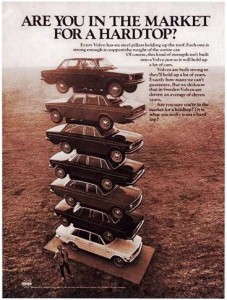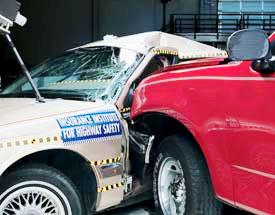Nineteen cars and eight SUVs earn the Insurance Institute for Highway Safety’s Top Safety Pick award for 2010 it was announced today. For the first time, good performance in a roof strength test to measure protection in a rollover is required to win.
These winners have safety performance that far exceeds U.S. Government requirements.
Top Safety Pick recognizes vehicles that do the best job of protecting people in front, side, rear, and now rollover crashes based on good ratings in Institute tests. Winners also must have electronic stability control, which research shows significantly reduces crash risk. This is the second time the Institute has tightened criteria since announcing the first recipients in 2005.
Front and side impacts and rollovers killed 24,056 passenger vehicle occupants in 2008. Rear-end crashes usually aren’t fatal but result in a large proportion of crash injuries. Neck sprain or strain is the most commonly reported injury in two-thirds of insurance claims for injuries in all kinds of crashes.
The Institute awarded the first Top Safety Pick winners to 2006 models and then changed its rating the next year by requiring good rear test results and electronic stability control as either standard or optional equipment.
Early this year the Institute alerted auto manufacturers to the new criteria for roof crush and asked them to nominate candidates for testing. The Institute has been criticized for the limited number of test it runs because a chance occurrence can drastically alter results, but not for its methodology.
Subaru is the only manufacturer with a winner in all four of the vehicle classes where it competes. Subaru earned five awards for 2010. Ford and subsidiary Volvo have six winners. Volkswagen and Audi have five. Chrysler earned four awards, which the Institute said continued a trend of improving the crashworthiness of its vehicles. Two new small cars, the Nissan Cube and Kia Soul, join the Top Safety Pick list for 2010.
Not a single model from the world’s biggest automaker by sales is represented among this year’s winners. Toyota and its Lexus and Scion subsidiaries had a strong showing in 2009 with 11 winners but were shut out for 2010.
Four other manufacturers whose vehicles have earned Top Safety Pick in the past didn’t have a qualifying vehicle for 2010: BMW, Mazda, Mitsubishi, and Saab.
The Honda Accord picked up the award the past 2 years, but the 2010 didn’t earn the required good roof strength rating to qualify (the roof is rated acceptable). The Ford Fusion is another mid-size car that dropped off the list for the same reason.

A new requirement for strong roofs cuts the list of winners from a record 94 in 2009 to only 27 this year.
“With the addition of our new roof strength evaluation, our crash test results now cover all 4 of the most common kinds of crashes,” said Institute president Adrian Lund. “Consumers can use this list to zero in on the vehicles that are on the top rung for safety.”
The new requirement for strong roofs winnows the list of Top Safety Pick winners from a record 94 in 2009 to 27. The addition of this criterion recognizes manufacturers with vehicles that provide good protection in rollovers, which kill more than 9,000 people in passenger vehicles each year.
The first rollover ratings were released in March. Vehicles rated “good” have roofs more than twice as strong as the current federal standard requires. The Institute estimates that such roofs reduce the risk of serious and fatal injury in single-vehicle rollovers by about 50% compared with roofs meeting the minimum requirement.
“Cars and SUVs that win Top Safety Pick are designs that go far beyond minimum federal safety standards,” Lund points out.
“Honda and Ford would have to make only minor changes to achieve good ratings for roof strength, as the Accord and Fusion just missed the mark,” Lund explains.
The mid-size Toyota Camry would have qualified with good ratings, except for its rear crash evaluation. This car’s seats and head restraints are rated marginal for protection against whiplash injury. A change to good would have earned the Camry a Top Safety Pick for 2010.
Other automakers have improved head restraints to win. For example, inadequate head restraints kept earlier Chrysler models from earning awards, but in 2010 the Chrysler Sebring, Dodge Avenger and Journey, and Jeep Patriot all earn good ratings and Top Safety Pick. Likewise, General Motors upgraded the seats and head restraints in the Chevrolet Malibu to win.
“In safety terms, we’ve come very far, very fast in just the past decade,” Lund says. “When the Institute began conducting frontal tests for consumer information in 1995, few vehicles earned top ratings. Now almost all do. Most cars failed the side tests we added in 2003. Test results in that initial round were so bad we nearly broke our budget for repairing the crash test dummy, but now most vehicles ace the side test thanks to side airbags and stronger side structures. Factor in improved head restraints to protect against whiplash and electronic stability control to prevent crashes, and consumers are the clear winners.”
Safety equipment is increasingly standard. Ninety-two percent of 2010 model cars, 99% of SUVs, and 66% of pickup trucks have standard side airbags with head protection. Electronic stability control is standard on 85% of cars, 100% of SUVs, and 62% of pickups.
“Now that roof strength is a priority, we think manufacturers will move quickly to bolster roofs to do well in our roof strength test. This means consumers likely will have more Top Safety Pick choices for 2011,” Lund predicts.
|
Top Pick Winners |
|
Large cars |
| Buick LaCrosse |
| Ford Taurus |
| Lincoln MKS |
| Volvo S80 |
|
Mid-size cars |
| Audi A3 |
| Chevrolet Malibu built after October 2009 |
| Chrysler Sebring 4-door with optional electronic stability control |
| Dodge Avenger with optional electronic stability control |
| Mercedes C class |
| Subaru Legacy |
| Subaru Outback |
| Volkswagen Jetta sedan |
| Volkswagen Passat sedan |
| Volvo C30 |
|
Small cars |
| Honda Civic 4-door models (except Si) with optional electronic stability control |
| Kia Soul |
| Nissan Cube |
| Subaru Impreza except WRX |
| Volkswagen Golf 4-door |
|
Mid-size SUVs |
| Dodge Journey |
| Subaru Tribeca |
| Volvo XC60 |
| Volvo XC90 |
|
Small SUVs |
| Honda Element |
| Jeep Patriot with optional side torso airbags |
| Subaru Forester |
| Volkswagen Tiguan |


Two comments:
– designing to US Government safety requirements (FMVSS) should be the bare minimum. All vehicles should far exceed them.
– roof strength requirements notwithstanding, a high number of deaths in rollovers is due to ejections from occupants not wearing seat belts.
Both are excellent points.
Debating whether a non-belted occupant would have lived if he or she stayed inside a vehicle even as the roof collapses makes little sense to me. Does it matter if the vehicle kills him by rolling over on him or the ejection results in another kind of fatal impact?
The fact remains that the seat belt is the single most effective safety device ever invented.
Don’t get caught sitting on it — rather than wearing it.
Toyota statement on IIHS claims:
On November 18, 2009, the Insurance Institute for Highway Safety (IIHS) issued a news release headlined: “27 Winners of 2010 Top Safety Pick Award.” Within the release, IIHS states: “Missing the mark: Not a single model from the world’s biggest automaker by sales is represented among this year’s winners. Toyota and its Lexus and Scion subsidiaries had a strong showing in 2009 with 11 winners but were shut out for 2010.”
Toyota is confident its vehicles are among the safest on the road today and is committed to the highest levels of vehicle safety and quality.
In 2009, Toyota won more IIHS Top Safety Pick (TSP) awards than any other manufacturer. Toyota continues to improve vehicle passive and active safety, including improvement of past winners of IIHS TSP.
IIHS’ statement that Toyota was shut out for 2010 is extreme and misleading, considering there are 38 Toyota, Lexus and Scion models, and only three were tested for roof strength by IIHS: Camry, RAV4 and Yaris.
This is the first year IIHS has included its own roof strength tests, which exceed federal standards, for TSP consideration. All Toyota vehicles meet or exceed Federal Safety Standards for frontal and side impact, roof crush resistance and rollover protection.
While passive collision protection is very important, Toyota also provides an array of active, passive, pre-collision and collision avoidance features. The “Star Safety System” is standard equipment on all Toyota and Lexus models.
The Insurance Institute’s ratings are one of many vehicle safety and quality metrics.
Irv Miller, Group Vice President, Environmental and Public Affairs, Toyota Motor Sales, U.S.A., Inc.